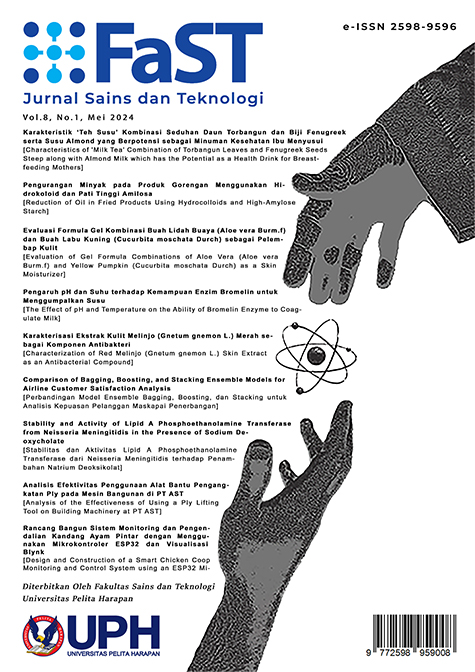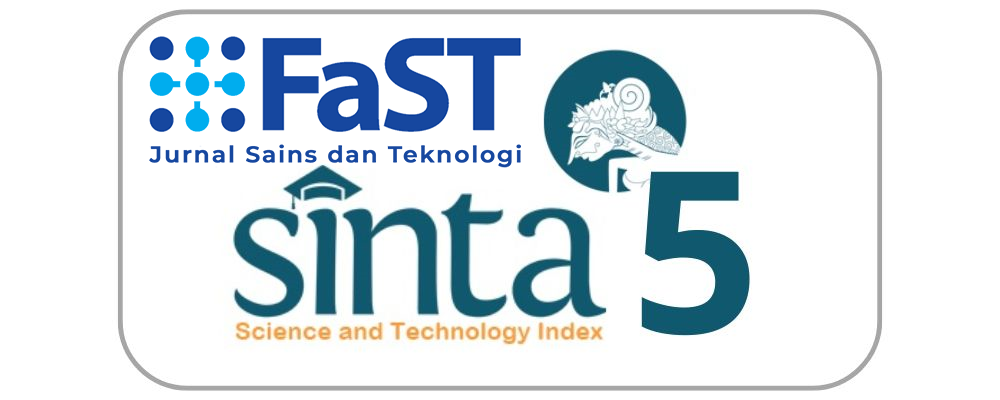EVALUASI FORMULA GEL KOMBINASI BUAH LIDAH BUAYA (Aloe Vera Burm.f) DAN BUAH LABU KUNING (Cucurbita moschata Durch) SEBAGAI PELEMBAP KULIT [EVALUATION OF GEL FORMULA COMBINATIONS OF ALOE VERA (Aloe Vera Burm.f) AND YELLOW PUMPKIN (Cucurbita moschata Durch) AS A SKIN MOISTURIZER]
DOI:
https://doi.org/10.19166/jstfast.v8i1.8260Keywords:
aloe vera, gel, moisture, pumpkin, skin moisturizersAbstract
Skin moisturizers are popular in the form of gel products. Natural ingredients that can be used to moisturize the skin are aloe vera and pumpkin, because they contain β-carotene which has strong antioxidant activity and flavonoids that can bond the water content in the stratum cSrneum. The combination of HPMC and carbopol 940 in the formulation of gel preparations is used as a gelling agent. The purpose of this study was to determine the effect of variations in the concentration of aloe vera and pumpkin on the physical characteristics of gel preparations and effectiveness in moisturizing the skin. The research steps of the extract were made by maceration method. Moisturizing gel was produced with LB:LK ratio in F1, F2, and F3 respectively (10:10), (12.5:7.5) and (15:5) and F0 as negative without extract. The evaluation included organoleptic test, adhesion, spreadability, pH, viscosity, and testing the effectiveness of the preparation in moisturizing the skin on respondents measured using Skin Moisture Oil Content Analyzer CR-302 Data analysis using one-way ANOVA. The results of the physical evaluation of the gel product organoleptically F0 is transparent, F1-3 is yellow to brownish, semi-solid, and has a distinctive smell of extracts. Analysis of spreadability, adhesion, pH, and viscosity tests showed significant differences between formulas. Formula 3 with LB:LK (15%:5%) ratio produced a moisture value of 51-62% on day 14 which was higher than the other formulas.
Bahasa Indonesia Abstract:
Pelembab kulit yang digemari oleh masyarakat umumnya dalam bentuk sediaan gel. Bahan alam yang dapat digunakan untuk melembapkan kulit yaitu lidah buaya (LB) dan labu kuning (LK), karena kandungan β-karoten yang memiliki aktivitas antioksidan yang kuat dan flavonoid yang dapat mengikat kandungan air pada stratum korneum. Kombinasi HPMC dan karbopol 940 dalam formulasi sediaan gel digunakan sebagai gelling agent. Tujuan penelitian ini untuk mengetahui pengaruh variasi konsentrasi lidah buaya dan labu kuning terhadap karakteristik fisik sediaan gel dan efektivitas dalam melembapkan kulit. Tahapan penelitian ekstrak dibuat dengan metode maserasi. Sediaan gel pelembab dibuat dengan perbandingan LB:LK pada F1,F2, dan F3 secara berturut-turut (10:10), (12,5:7,5) dan (15:5) serta F0 sebagai kontrol negatif tanpa ekstrak. Evaluasi yang dilakukan meliputi uji organoleptis, daya lekat, daya sebar, pH, viskositas, dan pengujian efektivitas sediaan dalam melembapkan kulit pada responden yang diukur menggunakan Skin Moisture Oil Content Analyzer CR-302. Analisis data dilakukan menggunakan one-way ANOVA. Hasil evaluasi fisik sediaan gel secara organoleptis F0 transparan, F1-3 berwarna kuning sampai kecoklatan, berbentuk setengah padat, dan berbau khas ekstrak. Analisis uji daya sebar, daya lekat, pH, dan viskositas menunjukkan adanya perbedaan signifikan antar formula. Formula 3 dengan perbandingan LB:LK (15%:5%) menghasilkan nilai kelembapan 51-62% pada hari ke 14 yang lebih tinggi dibandingkan formula lainnya.
References
Ardini, D., & Sumardilah, D. S. (2021). Efek lip balm ekstrak lidah buaya (Aloe vera) sebagai pelembab bibir. Jurnal Kesehatan Metro Sai Wawai, 14(1), 10-18. http://dx.doi.org/10.26630/jkm.v13i1.2677
Ariani, L. W., & Suharsanti, R. (2018). Pelembab alami sediaan shooting gel kombinasi lidah buaya dan buah rambutan. Jurnal Ilmiah Cendekia Eksakta, 3(1), 50-54.
Aryantini, D., Agustina, L., Kristianingsih, I., Kurniawati, E., & Khawarizmy, I. (2020). Formulasi dan karakteristik fisik soothing gel kombinasi lidah buaya dan buah naga. Cendekia Journal of Pharmacy, 4(1), 1-9. https://doi.org/10.31596/cjp.v4i1.51
Chairunnisa, S., Wartini, N. M., & Suhendra, L. (2019). Pengaruh suhu dan waktu maserasi terhadap karakteristik ekstrak daun bidara (Ziziphus mauritiana L.) sebagai sumber saponin. Jurnal Rekayasa dan Manajemen Agroundustri, 7(4), 551-560. https://doi.org/10.24843/JRMA.2019.v07.i04.p07
Fatimah, S., Prasetyaningsih, Y., & Baru, H. Y. (2021). Uji efektivitas ekstrak gel lidah buaya (Aloe vera) terhadap bakteri Propionibacterium acnes. Forte Journal, 1(2), 25-32. https://doi.org/10.51771/fj.v1i2.120
Goh, J. X. H., Tan, L. T., Yew, H. C., Pusparajah, P., Lingham, P., Long, C. M., Lee, L., & Goh, B. (2019). Hydration effects of moisturizing gel on normal skin: A pilot study. Progress in Drug Discovery & Biomedical Science, 2(1), 1-6. http://dx.doi.org/10.36877/pddbs.a0000023
Hasanah, N., & Novian, D. R. (2020). Analisis ekstrak etanol buah labu kuning (Cucurbita moschata D.). Parapemikir: Jurnal Ilmiah Farmasi, 9(1), 54-59. https://doi.org/10.30591/pjif.v9i1.1758
Leny, Ginting, I., Sitohang, T. N., Hanum, S. F., Hafiz, I., & Iskandar, B. (2021). Formulasi dan uji efektivitas sediaan body scrub labu kuning (Curcubita moschata). Majalah Farmasetika, 6(4), 375-385. https://doi.org/10.24198/mfarmasetika.v6i4.35776
Meilinda, F. R., & Astuti, M. (2023). The effect of using a traditional mask of Moringa leaves for dry facial skin care. International Journal of Natural Science and Engineering, 7(1), 40-48. https://doi.org/10.23887/ijnse.v7i1.58199
Rowe, R. C. Sheskey, P. J., & Quinn, M. E. (2009). Handbook of pharmaceutical excipient (6th ed.). Pharmaceutical Press and American Pharmacists Association.
Safriani, R., Sugihartini, N., & Yuliani, S. (2017). Physical characteristic and irritation index of Syzigium aromaticum essential oil in O/W and W/O creams. IOP Conference Series: Materials Science and Engineering, 259(1), 012005. https://doi.org/10.1088/1757-899X/259/1/012005
Sani, L. M. M., Subaidah, W. A., & Andayani, Y. (2021). Formulasi dan evaluasi karakteristik fisik sediaan gel ekstrak etanol daun salam (Syzygium polyanthum). Sasambo Journal of Pharmacy, 2(1), 1-6. https://doi.org/10.29303/sjp.v2i1.57
Saryanti, D., Nugraheni, D., Astuti, N. S., & Pertiwi, N. I. (2019). Optimasi karbopol dan HPMC dalam formulasi gel antijerawat nanopartikel ekstrak daun sirih (Piper betle Linn). Jurnal Ilmiah Manuntung Sains Farmasi dan Kesehatan, 5(2), 192-199. https://doi.org/10.51352/jim.v5i2.293
Siva, J., & Afriadi (2018). Formulasi gel dari sari buah strawberry (Fragaria X Ananassa Duchesne) sebagai pelembab alami. Jurnal Dunia Farmasi, 3(1), 9-15. https://doi.org/10.33085/jdf.v3i1.4416
Sunnah, I., Erwiyani, A. R., Pratama, N. M., & Yunisa, K. O. (2019). Efektivitas komposisi polivynil alkohol, propilenglikol dan karbomer terhadap optimasi masker gel peel-off nano ekstrak daging buah labu kuning (Cucurbita maxima D). Journal of Pharmaceutical Science and Clinical Research, 4(2), 82-94. https://doi.org/10.20961/jpscr.v4i2.34399
Ulaen, S. P. J., Banne, Y., & Suatan, R. A. (2012). Pembuatan salep anti jerawat dari ekstrak rimpang temulawak (Curcuma xanthorrhiza Roxb.). Jurnal Ilmiah Farmasi, 3(2), 45-49.
Wijayadi, L. J., & Kelvin. (2022). The role of essential oils on improving elderly skin hydration. Science Midwifery, 10(4), 3104-3111. https://doi.org/10.35335/midwifery.v10i4.769
Downloads
Published
Issue
Section
License
“Authors who publish with this journal agree to the following terms:
1) Authors retain copyright and grant the journal right of first publication with the work simultaneously licensed under a Creative Commons Attribution License (CC-BY-SA 4.0) that allows others to share the work with an acknowledgement of the work's authorship and initial publication in this journal.
2) Authors are able to enter into separate, additional contractual arrangements for the non-exclusive distribution of the journal's published version of the work (e.g., post it to an institutional repository or publish it in a book), with an acknowledgement of its initial publication in this journal.
3) Authors are permitted and encouraged to post their work online (e.g., in institutional repositories or on their website). The final published PDF should be used and bibliographic details that credit the publication in this journal should be included.”



